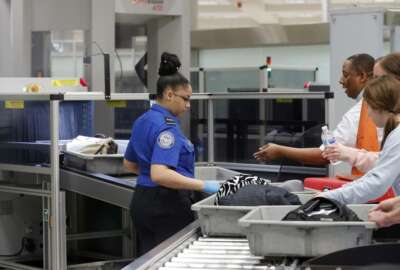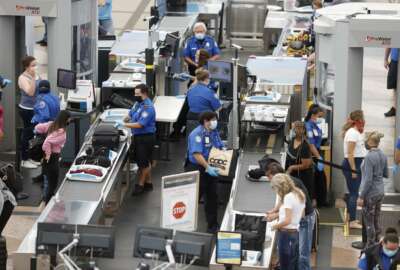
An Energy Department lab is perfecting a way to speed up TSA airport screening
Researchers at the Pacific Northwest National Laboratory have developed and are in the midst of commercializing a way to scan shoes still on their owners' feet.
Best listening experience is on Chrome, Firefox or Safari. Subscribe to Federal Drive’s daily audio interviews on Apple Podcasts or PodcastOne.
One of the most annoying and delay-inducing procedures in airport passenger screening is shoe removal. Now, researchers at the Pacific Northwest National Laboratory have developed and are in the midst of commercializing a way to scan shoes still on their owners’ feet. For more, Federal Drive with Tom Temin spoke with PNNL chief engineer Mark Jones.
Interview transcript:
Tom Temin: Mr. Jones, good to have you on.
Mark Jones: Thank you. Thank you very much.
Tom Temin: And of course, I am Pre, so I don’t have to take off my shoes, but the rest of the huddled masses do and it does take a long time. And TSA does complain about every millisecond adds up to the end of the line. So tell us what you’re working on here exactly. What is it about shoes that require unique engineering to see through?
Mark Jones: That’s a good question. So the goal of the shoe scanner, of course, was to develop technology that would allow us to keep our shoes on at the airport security checkpoints. That’s the main issue for travelers, as you know. And we would like to speed up that process and reduce wait times improving the overall passenger experience. So our system is based on the same millimeter wave technology that’s used in the airport body scanners. But in this case, we stand on a low profile platform, and then the data is collected by antennas underneath that platform.
Tom Temin: Well, it sounds like this is more of a mechanical engineering job than electrical engineering one.
Mark Jones: Yes, it’s actually both. So it requires the multi disciplinary team. And that’s who developed it here at the laboratory. We have electrical engineers, microwave engineers and 10 engineers, mechanical engineers, software engineers. So it’s really a nice example of a multidisciplinary problem dissolve.
Tom Temin: Let me just ask you a amateur engineers technical question. When you walk into one of those booths, and something moves around you or whatever, you’re at some distance from the source of the energy that is looking through you, when you’re standing on something, was there a challenge in the contact aspect of it to disperse the radiation such that you could see the hidden knife, or whatever might be down in a shoe? Maybe Maxwell Smart had a phone down in there?
Mark Jones: The shoe scanner is a much different problem in terms of complexity. So for the body scanners that scan around you, obviously, those are intended to look through the clothing. And to detect objects that are underneath the clothing for the shoe scanner, we have to couple very closely to get the energy into the shoes and the multiple layers that make up the shoe and the tread patterns. Anything else that may be ordinary shoes. So yes, it’s a much more complex problem. And we wanted to extend the technology that we’ve developed for the body scanning application, to see if it was applicable for commonly worn types of footwear.
Tom Temin: Plus, with people standing on it, some people are heavy, some are light. And so there’s different amounts of pressure on top of this thing, plus the sheer number of people stepping over it, there’s a kind of a mechanical strength and durability factor. Is that part of the work that you’re doing also?
Mark Jones: Yes, that was very much a part of the initial studies, where we evaluated different types of interfaces for the footwear scanning layer for the antennas to be able to see through a microwave transparent layer but also evaluate different options that would have mechanical rigidity and structural strength.
Tom Temin: And I guess the other implication of this, again, from an engineering standpoint is that whatever equipment they were using to examine other things, somehow could not be rejiggered to be able to see down into shoes, could it?
Mark Jones: That’s right. This requires a unique system that would look up into the bottom of the shoe, so that we can understand anything that’s concealed within the shoe. any modifications that may be happening there or concealed items.
Tom Temin: I guess at that point, it becomes a matter of training, because some people wear shoes with steel toes in them occasionally to the airport. I don’t know why they would, but they do.
Mark Jones: Yeah, that’s correct. And our sponsor, the Department of Homeland Security, they commissioned a survey of the traveling public, to study the behavior and to understand what types of shoes are worn in the airports today. And from that research, we found that most people were very agreeable and willing to modify their behavior to use this type of screening system.
Tom Temin: And in fact, do test show that it can save time of people in line, right? Yes, we expect it to save time, because you don’t have to take your shoes off for most of the types of shoes that we’ve seen. So it can really speed people through and the longer the line, the more the effect is each interval of time that are shaved off the process.
Mark Jones: That’s right. I think we’re estimating around 15-to-20% of times they
Tom Temin: We’re speaking with Mark Jones, he’s a chief engineer at the Pacific Northwest National Laboratory, part of the Energy Department. And how do you go about engineering this thing? Do you build plastic prototypes? I mean, it sounds like a fun thing to try to engineer.
Mark Jones: So we started with a laboratory prototype system that we built here in our laboratory, and it was an engineering study. So we were able to use that system to understand which types of antennas to use all kinds of variables there from an engineering standpoint. So that was our first attempt to study that. Once we did that, very quickly. In about a year, we built a deliverable system that was a vote profile. refined system for use in the Transportation Security laboratory. And that system is currently being further evaluated against a wide range of scenarios and shoe types.
Tom Temin: And so how does this whole structure then get out into the marketplace? I guess there’s a number of things that have to happen, somebody has to make it commercially. And of course, TSA has to be convinced or convinced themselves that it will work in their setting. And that’s a pretty complicated set of eventualities. What are you doing to help get it commercialized?
Mark Jones: So we’ve currently licensed the technology to a commercial partner, we’re excited with them to transition into a product that can make it into the market. Any decision to use the type of system that we’re evaluating for scanning shoes in the actual airports would of course be made by the Transportation Security Administration?
Tom Temin: And do they test and otherwise consult with you in the development process? Or do they wait till the commercial partner delivers a prototype? I mean, they’ve been there all along with you.
Mark Jones: We work very closely with them. And I expect them to work very closely with any acquired hardware to continue to understand what it can do and to set the requirements going forward for any deployed system.
Tom Temin: And if someone else wants to license this, because they think they can build a better mousetrap will that intellectual property from p, n and l be available to others?
Mark Jones: Eventually, currently, it’s a limited term exclusive license. And after that term expires, then it will be available.
Tom Temin: And by the way, how long does it take to test shoes when you stand on the platform?
Mark Jones: It takes approximately two seconds to scan the shoes.
Tom Temin: You can’t even get flip flops off and on that fast.
Mark Jones: That’s right.
Tom Temin: Alright. And what’s next for the lab? Sounds like you got a lot of interesting projects going on there. You’re in the millimeter wave technology business specifically, is that fair to say?
Mark Jones: That’s true. So we are advancing the state of the art for millimeter wave technology in the area of national security. So we have a portfolio of projects that are examining different types of screening scenarios, looking at next generation imaging technologies to improve what’s out in the airports today. As you know, we delivered the technology and license that for the original body scanners that are at the airport that was licensed by PNNL about 15 years ago. And so we’ve been working to develop the next generation of those systems to see what that would look like and understand how that would improve detection capabilities.
Tom Temin: Is there kind of a holy grail that TSA is seeking in terms of scanning technology? I’m, I’ll just make this up. You can be screened and scanned and Okay, from when you walk through the door in the airport as a kind of a Jetsons type of model. But is that how they look at things?
Mark Jones: Yes, our sponsor is the Department of Homeland Security Science and Technology Directorate. And they have a screening at speed program that evaluates transformational technologies for that purpose.
Tom Temin: So this is really just a step, no pun intended, toward that ultimate goal of almost instantaneous screening if the technologies could be assembled to cause that.
Mark Jones: That’s great. Yeah, the ideal goal is to have a set of technologies that can be applied to improve the passenger experience, and to improve the convenience going through the airport, but maintain the same security capabilities.
Tom Temin: And by the way, in the testing, and this will be my final question. Did you really try to fool the machinery like putting a tiny brand that you might mount a small picture on inside a shoe, that kind of thing? I mean, not everything necessarily has to be giant, a huge chunk of metal to be detectable?
Mark Jones: Yes, that’s correct. We in our initial testing performed a wide variety of scenarios to understand what could be detected. The system has very good overall capabilities, but the specific types of threats that are able to be detected are being evaluated currently by the TSL.
Tom Temin: Alright. Mark Jones is a chief engineer at the Pacific Northwest National Laboratory. Thanks so much for joining me.
Mark Jones: You’re welcome.
Copyright © 2025 Federal News Network. All rights reserved. This website is not intended for users located within the European Economic Area.
Tom Temin is host of the Federal Drive and has been providing insight on federal technology and management issues for more than 30 years.
Follow @tteminWFED





